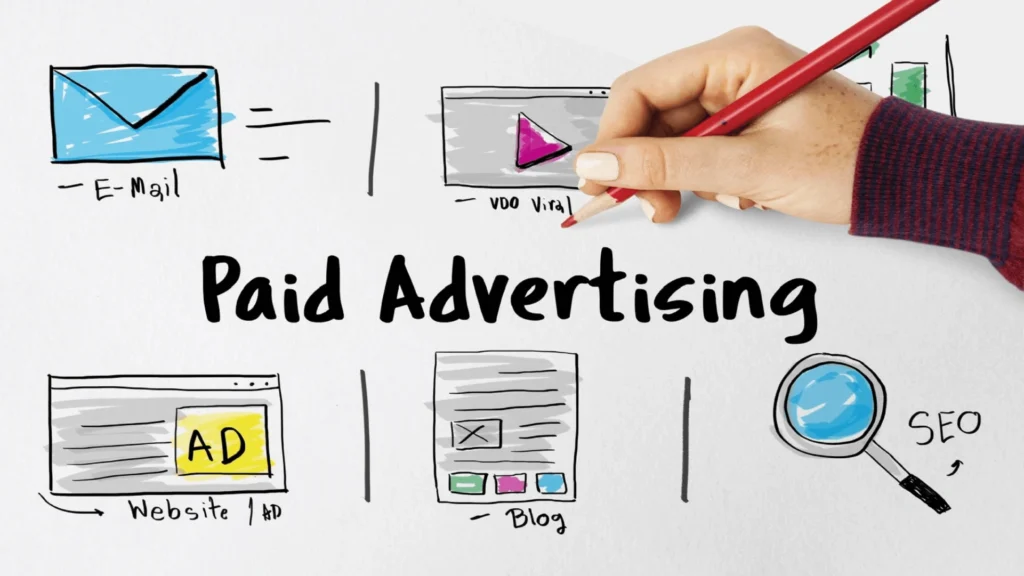One of the most effective ways for businesses to reach potential customers online is through paid search advertising, a strategy that allows you to bid on keywords aligned with your products or services. In this guide, we’ll explore the essentials of paid search, highlight its benefits and challenges, provide actionable tips, and share examples of campaigns that successfully convert clicks into customers.

Content
What is Paid Search Advertising?
Paid search advertising, also known as Search Engine Marketing or Pay-per-click, is a form of digital marketing where advertisers pay to display their ads on search engine results pages. These ads typically appear above or alongside organic results, giving businesses prime visibility for relevant searches.
By targeting specific keywords and audiences, companies can increase brand awareness, drive traffic, and boost sales in a measurable way. Paid search advertising is not just about placing ads—it’s about placing the right ad in front of the right audience at the right time.
Advantages and Challenges of Paid Search
Advantages
- Instant Visibility: Ads appear at the top of search results immediately after launching a campaign.
- Targeted Reach: Focus on specific keywords, locations, devices, and demographics to reach potential customers efficiently.
- Measurable ROI: Track clicks, impressions, and conversions to evaluate campaign performance and make data-driven decisions.
- Remarketing Opportunities: Re-engage visitors who have already shown interest in your products or services.
Challenges
- Competition and Cost: Popular keywords can be expensive due to competitive bidding.
- Ad Fatigue: Users may ignore repetitive ads if campaigns aren’t refreshed with new creative regularly.
- Learning Curve: Effective campaigns require expertise in keyword research, ad copywriting, bid strategies, and analytics.
- Click Fraud: Competitors or bots can drive up costs without generating actual leads if proper safeguards aren’t in place.
Elements of an Effective Paid Search Campaign
Creating a successful paid search campaign involves several key components:
- Compelling Ad Copy: Write clear, engaging copy with strong calls-to-action that address user needs. Incorporate benefits, urgency, or special offers to stand out.
- Landing Page Optimization: Ensure users find a relevant, mobile-friendly, and fast-loading page after clicking the ad.
- Bid Strategy: Use manual or automated bidding strategies to maximize ROI. Consider options like cost-per-click, cost-per-acquisition, or target return on ad spend.
- Continuous Monitoring and A/B Testing: Analyze performance metrics regularly and test different headlines, ad copy, and landing pages to improve results.
Examples of Successful Paid Search Advertising
1. E-commerce Retailer Boosts Holiday Sales
An online store ran a PPC campaign targeting holiday-specific keywords. By creating separate ad groups for each product category and testing multiple ad variations, the retailer increased conversion rates by 35% during the season.
2. Local Service Provider Increases Leads
A local plumbing company used paid search advertising to target “emergency plumbing services near me.” Optimized ad copy and location targeting resulted in a 50% increase in service calls within three months.
3. SaaS Company Generates Trial Sign-Ups
A software company targeted high-intent keywords like “project management software free trial.” Strong CTAs and highly relevant landing pages led to a 40% higher conversion rate than previous organic efforts.
4. Travel Agency Boosts Seasonal Bookings
A travel agency promoted seasonal travel packages through search engine marketing campaigns. By targeting specific phrases such as “summer beach vacations,” the company saw a 25% increase in bookings over one month.
Advanced Tips for Maximizing Paid Search Performance
- Use Negative Keywords: Prevent your ads from showing for irrelevant searches, saving budget and improving ROI.
- Incorporate Ad Scheduling: Display ads at times when your target audience is most likely to convert.
- Optimize for Mobile Users: Mobile-friendly ads and landing pages are crucial as mobile searches dominate the market.
- Monitor Quality Score: Google assigns a Quality Score to keywords based on relevance, click-through rate, and landing page experience. Higher scores reduce cost per click and improve ad placement.
Conclusion
Paid search advertising is a powerful, measurable way to grow your business online. By understanding the fundamentals, selecting the right keywords, crafting engaging ads, and continuously optimizing campaigns, you can attract high-intent visitors and generate tangible results. From e-commerce stores to local service providers and platforms, SEM and PPC strategies help businesses increased visibility, drive conversions, and achieve growth in a competitive digital landscape.
FAQs
What is paid search advertising?
Paid search advertising, also called SEM or PPC, is when businesses pay to display ads on search engine results pages for targeted keywords.
How does paid search differ from SEO?
Paid search delivers immediate results through ads, while SEO focuses on organic ranking improvements over time.
What are the benefits of paid search campaigns?
Benefits include instant visibility, targeted reach, measurable ROI, flexible budgeting, and the ability to re-engage previous visitors.

A business blog writer at the age of 19, Francis is a jack-of-all trades when it comes to writing. He specializes in content creation for businesses and blogs. With years of experience under his belt, he’s able to provide both written and video content that will engage readers and viewers alike!

